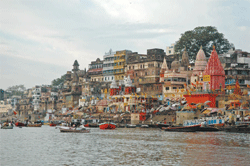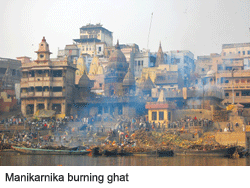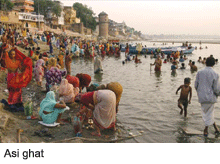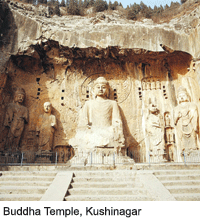In 2008, 400,000 foreign and 900,000 domestic tourists and pilgrims visited Varanasi (formerly Banaras or Kashi) making it the most frequented destination of the Indian subcontinent. For orthodox Hindus, it’s the most favoured place to die and be cremated
 In February of 2007 I stepped out of a rudimentary airport and inhaled the air of arguably the oldest city of the world. At least Mark Twain, the American author and litterateur, thought so. “Banaras is older than history, older than tradition, older even than legend and looks twice as old as all of them put together,” observed Twain.
In February of 2007 I stepped out of a rudimentary airport and inhaled the air of arguably the oldest city of the world. At least Mark Twain, the American author and litterateur, thought so. “Banaras is older than history, older than tradition, older even than legend and looks twice as old as all of them put together,” observed Twain.
But contemporary Varanasi (pop. 3 million), as it was renamed in 1947, is a holy city sandwiched between old and the new. Its ancient temples lie cheek-by-jowl with new buildings. Old dhabas on the street corners adjoin 5-star hotels. It’s a different, unique world.
Varanasi aka Kashi is a city of paradoxes. The buzzing streets, over-stocked shops, flies, masses of people, narrow lanes and alleys, noisy vendors and rickshawallas can add up to intimidate a rookie traveler. The city is not for the faint-hearted as its sensory overload could leave first-time visitors reeling. Nor does it reveal itself easily, testing the traveler to great extreme. Yet there are not a few who discern the spiritual peace and calm it offers, and revisit regularly.
In 2008, 400,000 foreign and 900,000 domestic tourists and pilgrims visited Varanasi, making it the most frequented destination of the subcontinent. Among the seven sacred cities and the epicentre of pantheistic Hinduism, it hosts one of the 12 jyotir linga sites and also a shakti pitha site, and for orthodox Hindus it is the most favoured place to die and be cremated. Legends and hymns extoll the healing power of the waters of the Ganges as the medium of Shiva’s divine essence, and a ritual bath in the river is believed to wash away all sins. The riverine location of Varanasi is considered especially auspicious because within 10 km of this city the Ganges, which flows through it, confluences with two other rivers, the Asi and the Varana.
The holiest of holy cities of the estimated 800 million Hindus of the Indian subcontinent and the diaspora, Varanasi is believed to host 80,000 shrines of various deities of the Hindu pantheon and over 500,000 images of the deities. Since a devout pilgrim would require an entire lifetime to visit each of these shrines, many who visit the city never leave.
Its shrines apart, this sacred city also houses 10,000 temples dedicated to different gods and goddesses. Some of these temples are named after the great tirthas, or pilgrim centres of India — Kanchipuram, Dwarka, Puri and Rameswaram, for example — and it is widely believed that by visiting Varanasi, a pilgrim attains the spiritual benediction of having visited all the major pilgrimage centres of Hinduism. Apart from the 1.3 million visitors the city receives annually, Varanasi’s stable population also hosts an estimated 45,000 elderly jivan muktas (‘liberated while still alive’) who stay put in this holiest of cities and live out their last years in its sacred and spiritually infused environment.
City of the Dead
Kashi is also traditionally known as mahashamshana, or ‘the great cremation ground’, the popular belief being that if one is cremated on the banks of the Ganges at Varanasi, the soul is released from its endless cycle of rebirth. Because of this belief, the dead and dying are transported from distant lands for ritual cremation in Varanasi — particularly to the most sacred site of Manikarnika, associated with the goddess Parvati, Lord Shiva’s consort.
On the banks of the sacred Ganges which flows through the city, death is an omnipresent reality. Taut corpses wrapped in golden fabric burning on riverside funeral pyres, known as ghats, are a common sight. Simultaneously the city’s streets are thronged by cloaked biers borne by chanting families. Yet somewhat paradoxically, tearful mourners are conspicuously absent because Hindus believe that dying in Kashi is a valuable opportunity reserved for the favoured few. Nearly 250 corpses are cremated on Varanasi’s 80 ghats on an average day.
Doms of Kashi
 The ghats and cremation grounds of Varanasi are maintained by the Dom community. The Doms are keepers of the sacred fire, which is never allowed to die, and they have been cremators of the dead for over a millennium. They regard themselves as descendants of Kalu Dom, who worked as a cremation undertaker during the regime of Raja Harishchandra, a pious king of ancient times. It is said that if the person being cremated is to achieve moksha, the fire for his funeral pyre must be taken from the Dom Raja. The Doms of the major ghats — Manikarnika, Harish-chandra, Asi etc — are known as rajas or choudharies. They number about 30 in Varanasi with 430 other cremators constituting the second rung of the Dom hierarchy.
The ghats and cremation grounds of Varanasi are maintained by the Dom community. The Doms are keepers of the sacred fire, which is never allowed to die, and they have been cremators of the dead for over a millennium. They regard themselves as descendants of Kalu Dom, who worked as a cremation undertaker during the regime of Raja Harishchandra, a pious king of ancient times. It is said that if the person being cremated is to achieve moksha, the fire for his funeral pyre must be taken from the Dom Raja. The Doms of the major ghats — Manikarnika, Harish-chandra, Asi etc — are known as rajas or choudharies. They number about 30 in Varanasi with 430 other cremators constituting the second rung of the Dom hierarchy.
Ghats of Varanasi
 The epicentre of the spiritual life of Varanasi are its 80 ghats, most of which are used for ritual bathing, with some known as the burning ghats on which bodies are cremated in public. The most famous of Varanasi’s ghats which line the Western bank of the Ganges is Asi, situated near the confluence of the River Asi and the Ganges. The ideal time to visit the ghats is at dawn, when pilgrims offer puja and obeisance to the emerging sun rays, bathing the river in an ethereal glow. At sunset, again, glittering diyas are set afloat at Dasaswamedh Ghat, accompanied by the Ganga aarti (prayer), which, when it reaches a crescendo, unleashes a spiritual frenzy among the yogis and ascetics thronging the site.
The epicentre of the spiritual life of Varanasi are its 80 ghats, most of which are used for ritual bathing, with some known as the burning ghats on which bodies are cremated in public. The most famous of Varanasi’s ghats which line the Western bank of the Ganges is Asi, situated near the confluence of the River Asi and the Ganges. The ideal time to visit the ghats is at dawn, when pilgrims offer puja and obeisance to the emerging sun rays, bathing the river in an ethereal glow. At sunset, again, glittering diyas are set afloat at Dasaswamedh Ghat, accompanied by the Ganga aarti (prayer), which, when it reaches a crescendo, unleashes a spiritual frenzy among the yogis and ascetics thronging the site.
By traversing the 65 km sacred path known as the Panchakroshi Parikrama, pilgrims can circumambulate Kashi, visiting 108 shrines of the ghats along the way. For the devout with less time and energy, a visit to Panchakroshi Temple will suffice. By walking around the sanctuary of this shrine, with its 108 wall reliefs of the temples along the sacred way, pilgrims complete a symbolic journey around the sacred city. Another important pilgrimage route is the Nagara Pradakshina, which takes two days to complete and covers 72 shrines.
Travelers looking for a little more splendour can head to the Vishwanath temple. Also known as the Golden temple, the original was located across the road, but was destroyed by Emperor Aurangzeb who had built a mosque over it. Dedicated to Vishveswara — Shiva as lord of the universe — it was built in 1776 by Ahalya Bai of Indore, with an imposing 800 kg gold-plated dome added 50 years later. Next to the temple is the Gyan Kupor Well (well of knowledge), whose water is believed to lead devout pilgrims to a higher spiritual plane, although tradition and a strong security screen prevent most from drinking from the well.
Silks of Varanasi
Besides being known as the sacred site for death and salvation, Varanasi is also renowned for its fine silks and brocades. A Banaras silk sari or shawl is traditionally a single coloured textile with motifs and patterns woven in gold or silver threads. The technique is intricate, the procedure complex and demands great expertise. The smaller and more intricate the design, the more elaborate the weaving skills. Silk weaving in Banaras is an ancient tradition, with weavers being predomi-nantly Muslim and the art being passed down in families. There are shops in Banaras offering a wide range of gossamer silks of the very finest texture.
Banaras Hindu University
An ancient and venerable centre of learning, Varanasi continues its tradition today at the highly-regarded Banaras Hindu University (estb. 1916), founded by nationalist Pandit Madan Mohan Malaviya as a centre for education in Indian art, music, culture and philosophy, with a focus on Sanskrit studies. The wide, tree-lined 5 sq. km campus and parkland is a serene haven for visitors weary of the clamour and chaos of the surrounding city. On campus, the Bharat Kala Bhavan is an airy museum with a splendid collection of miniature paintings, 12th century palm leaf manuscripts, sculpture and local history displays.
Sarnath
.gif) Only 10 km from varanasi, curious tourists can visit the deer park where the Buddha preached his first sermon — ‘Maha-Dharma-Chakra Pravartan’ — after his Enlightenment. Sarnath is one of the richest centres of Buddhist antiquities, ranging in date from the time of the Mauryan Emperor Ashoka. After the decline of Buddhism, Sarnath lay forgotten until a British archaeologist excavated the site in the 19th century. He discovered stupas and a pillar originally erected by Emperor Ashoka in the 3rd century BC.
Only 10 km from varanasi, curious tourists can visit the deer park where the Buddha preached his first sermon — ‘Maha-Dharma-Chakra Pravartan’ — after his Enlightenment. Sarnath is one of the richest centres of Buddhist antiquities, ranging in date from the time of the Mauryan Emperor Ashoka. After the decline of Buddhism, Sarnath lay forgotten until a British archaeologist excavated the site in the 19th century. He discovered stupas and a pillar originally erected by Emperor Ashoka in the 3rd century BC.
The biggest stupa, Dham-ekh, was on the site where the Buddha is believed to have given his first sermon, seated with the Brahmins from Kapilavastu. Later archaeol-ogists discovered the shrine where the Buddha reportedly sought shelter from the rains. A temple built by the Sri Lankan Buddhist Anagarika Dharmapala now stands in place of the shrine. The ruins of several monasteries lie amid vast green lawns.
Kushinagar
 Around 250 km from varanasi is the site of the Buddha’s death, Kushinagar, located next to Kasia, a rural town in the state of Uttar Pradesh. Kushinagar is one of the four major pilgrimage destinations said to have been authorised by the Buddha himself. Many of the ruined stupas and viharas of Kushinagar date back to the 3rd century BC and 5th century AD, when prosperity of this town was at its peak. Emperor Ashoka is known to have contributed significantly to the monasteries and pillars at this site.
Around 250 km from varanasi is the site of the Buddha’s death, Kushinagar, located next to Kasia, a rural town in the state of Uttar Pradesh. Kushinagar is one of the four major pilgrimage destinations said to have been authorised by the Buddha himself. Many of the ruined stupas and viharas of Kushinagar date back to the 3rd century BC and 5th century AD, when prosperity of this town was at its peak. Emperor Ashoka is known to have contributed significantly to the monasteries and pillars at this site.
Prior to its rediscovery in the 19th century, there was a silence of more than half a millennium at Kasia. Possibly due to violent invasions, Kushinagar lost its vitality and was eventually neglected. The notable Buddha temple, when rediscovered, was covered in a 40 foot high mound of bricks surrounded by a dense thorny forest. Today, Kushinagar is a much-frequented pilgrimage site, especially for Buddhists from Asian countries
How to reach Varanasi
By air: The closest airport is Babatpur, 22 km northwest of the city.
By road: Most buses terminate in the vicinity of the railway station. The Cantonment bus stand tends to be used by services from Nepal and Gaya, while private operators and buses from Mirzapur and Chunar use the Pilikothi bus stand and another private bus stand at Lahar Tara, 1 km west of the railway station where buses arrive from Lucknow and Allahabad.
Getting around. Besides cycle and auto-rickshaws there is a city bus system, although it’s not recommended. The best way to get around is by shared auto-rickshaws or tempos. Bicycle rental is available at Rs.20 an hour.
Accommodation. Varanasi has various types of accommodation depending on one’s budget. There are guesthouses and comfort and luxury hotels as well. A room at Asi ghat facing the river is worth considering, as the view is spectacular.
Top-end: Taj Ganges (Rs.10,000 per night); Clarks Varanasi (Rs.4,000); Palace on Ganges (Rs.2,970). Mid-range: Ganges View (Rs.2,500); Hotel Haifa (Rs.900); Rashmi Guest House (Rs.2,500). Budget: Ganga Fuji Home (Rs.300); Hotel Alka (Rs.250); Scindia Guest House (Rs.450).
Neha Ghosh